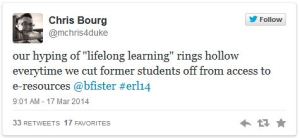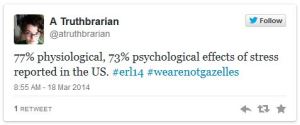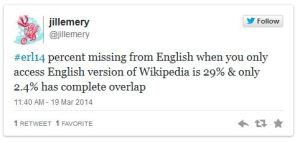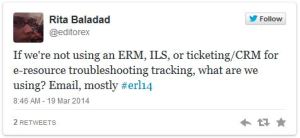Intota Implementation: User Experiences #PQsummit
Presenter: Sandra Morden, Head, Discovery and Technology Services, Queens University, Ontario, Canada
Presenter: Michael Vandenburg, Associate University Librarian, Queens University
Presenter: Ashley Zmau, E-Resources Librarian, University of Texas at Arlington Libraries:
Michael Vandenburg and Sandra Modern from Queens University started off this two-part session. Their presentation, There is no Manual: Challenging traditional workflow processes and developing problem-solving skills, described their migration path to Intota, which occurred during a period of significant change at their institution. A primary result of that change, structurally, was increasing support for e-resource by combining a team of e-resources and collection development. Other workflow tactics used along with this restructuring included consolidating subscription vendors and reduce shadow systems. Intota went live for them in August 2014 without a RFP, more as an upgrade of existing Serials Solution system.
Morden picked up the presentation at this point describing the Intota interface implementation. The Intota interface is different, but the underlying features are the same. [And in this reporter’s humble opinion, that is precisely the problem!] Morden had hoped the implementation would provide for more directed process, but instead that they were already using the product mostly as expected, but made a few minor adjustments. She suggested that role-based task lists that would be more helpful for connecting staff to the system and workflows of electronic resource. Lacking this, required different approach to staff training program focused on understanding the larger concepts and interest in problem-solving skills. They built on previous training in the use of existing ticketing system, and also built personnel skill in independent problem solving and accountability with a greater understanding of referral. The training involved a series of workshops with practical exercises. Overall they were left with questions, like: Is this all there is? Are there just not there better ways? Looking forward to collaborative futures that will help with consortial partnerships in development. Morden expressed optimism for what could be to learned from the next presenter, Ashley Zmau, E-Resources Librarian, University of Texas at Arlington (UTA) Libraries.
Zmau presented an Overview of how Intota can Meet the Needs of your Library Now which started with an immediate recommendation to begin using a team email account with subscription agents, vendors and publishers in order to better manage communication and workflows. This recommendation and the structure of all her recommendations followed what Zmau called operating by the “hit by bus” model.
Highlighting Renewal Details customization, she showed how UTA only used a handful of the many fields available, and took advantage of certain field to code key information (like the Renewal Note field for PO#). Renewal Checklist is a favorite feature which UTA uses three ways, for Renewal, License and New Order. These allow her to delegate renewal task to other staff through the use of checks and the text fields associated with those checks to include staff initials and date. This helps to troubleshoot problems. Multiple people updating the checklist at any given time. [But this reporter has oft complained that this feature still does not include an update trigger that would email the next person to act.]
Use of Collections was another valuable feature. UTA used it for resource for which they partner with their business school. This was important for the various people involved in the renewal, as well as the fact that this particular renewal must be renegotiated annually.
Zmau offer key tips for developing documentation, including these three necessary components: 1) What, 2) why and 3) where to look. Having theses components in all documentation helps develop higher level thinking and independent decision making among staff. Zmau also recommended including staff in development of menus and menu definition and other documentation.
My Intota feature is another favorite, especially the My Databases page. This page includes at a glance renewal dates and quick access icons that save time by requiring less clicks through buried screens. They allow title list, renewal checklist, contacts, and license data associated with a database to be readily available. Reporting features allow to see the larger overview of where workflows are at any given point. Management Reports show list of databases with key info.
Zmau noted a number of alerts that could be assigned to individuals and prepopulated with notification email text . [But this reporter has oft complained that this feature doesn’t allow you to select from preexisting contact list, or assign to different contact based on say, the resource (not the alert), all of which is necessary for these team-based workflows!]
Questions from the audience:
Q: What kinds of staff resistance was encountered and how did you address?
A: Less resistance since we had been using Client Center — joked that biggest difference b/w the two is that one is blue and one is green. Beta partnership also helped in being able to say what is coming down the development track.
Q: What would be the ideal “manual” if there was one?
A: Not step by step, more along the lines of best practices. Remove dependence upon step by step and screen shot approach in order to get to more self-directed learning expectations [and to keep up with the rate of change!]
A: The ideal system too would enable staff to see what the next logical step is.
A: Important for any manual to capture local and historic decision context for each resource.
Q: Say more about Drupal database use and its connection of this to ERM?
A: “Database of databases” used, but is actually manually connected to KB, because its information is more public facing than administrative and that this list predated licensing of Client Center/Intota.
A: First step at UTA was to match these lists against each other.



